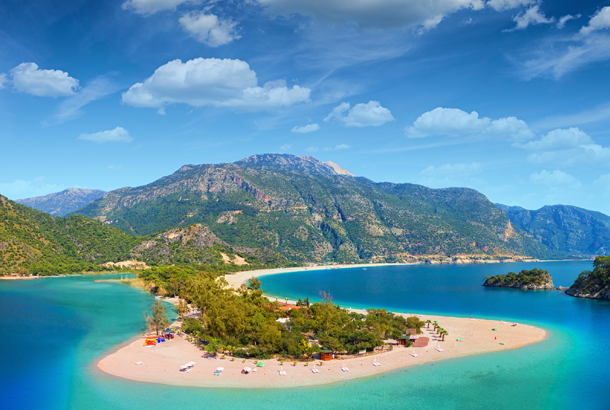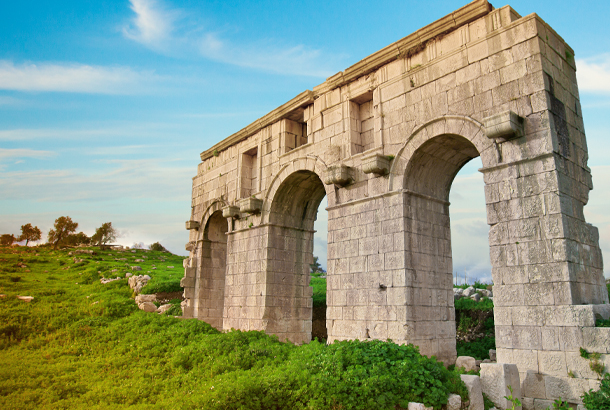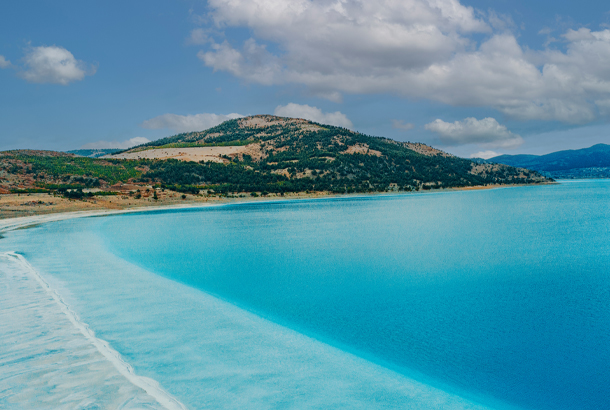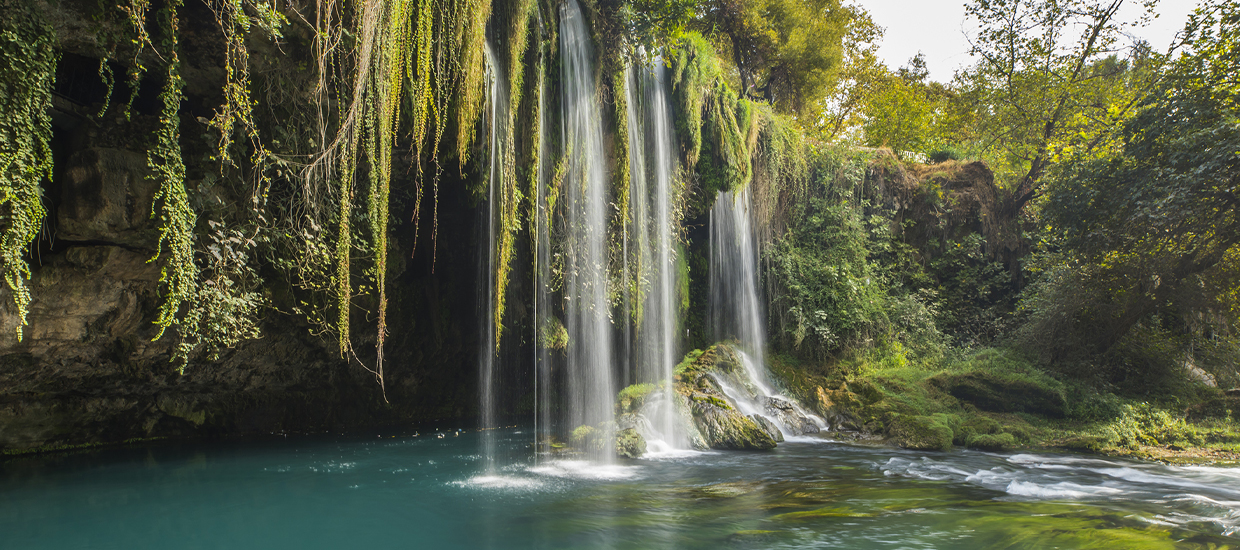If you are a traveler looking to reduce your carbon footprint by exploring less industrialized and invasive terrain, Türkiye is the destination for you with its surprising ecological and cultural diversity. Here is a selection of green adventures and sustainable experiences that will introduce you to the country’s unblemished nature reserves, towering mountains and pristine beaches & lakes with minimal impact on mother earth. With magnificent heritage sites, diverse flora and fauna and welcoming local cultures, your epic and picturesque adventure await.
1) Türkiye: An Aerial Crossroads
Throughout history, Türkiye has not only been a conduit for cultures and ideas, but also for the migratory birds for whom the country’s skies serve as a flyway for their seasonal journey between Africa and Europe. Two of the most important global bird migration routes pass over Türkiye, through which a variety of fowl relocate to their breeding grounds in the northern hemisphere each spring to escape the southern heat, reversing the journey each autumn. Türkiye’s great variety of mountains, forests, coasts and wetlands offer a bountiful if transitory home for more than 450 bird species. Hatay acts as a migration gateway to the peninsula of Anatolia, the mainland of Türkiye, while the Bosphorus and Çanakkale straits provide a convenient corridor for birds en route to Europe. Every spring and autumn, the sky of İstanbul fills with hundreds of thousands of storks, hawks and eagles -granting an unrivaled viewing opportunity for bird watchers from around the world. Prime vantage points in İstanbul include the Sarıyer and Çamlıca hills. Indeed many bird sanctuaries can be found around the country, including the Gediz and Büyük Menderes deltas near İzmir. The pristine lakes of Manyas, Uluabat and Bafa, host waterfowls like flamingos, herons and pelicans annually. Artvin and Iğdır (Kars) also provide important ecosystems for those bird species who instead migrate to the Caucasia, each year.
Travel tip: The best months to observe the great annual migration over Turkish skies are March-May in the spring and August-October in the summer/autumn.
2) The Mythological Land of Olive Trees
On the North Aegean coast of Türkiye, overlooking the Gulf of Edremit, lies the storied mountain range of Kazdağı (Mount Ida) with its soaring peaks, healing springs, and rustic villages. This picturesque locale is not only a popular current destination for seaside holidays and yoga retreats but also a place rich in Türkiye’s agricultural history. The majority of Türkiye’s olive groves can be found here, making the nation the second-largest olive oil producer in the world. Some of the olive trees in the region are hundreds of years old, providing a direct link to the country’s long history of producing this age-old staple. Adatepe and Ayvalık are home to small local olive producers, as well as museums and tasting centers, converted from centuries-old olive oil workshops and factories. For outdoor enthusiasts, tours of Kazdağı National Park feature valleys, canyons, streams and waterfalls all connected with majestic trails (and including English-speaking guides on request). Among the 800 plant species known to the region, 78 are endemic, making the area one of Europe’s leading botanic reserves. The area also offers several day trip options, including Gökçeada -Türkiye’s first cittaslow island- as well as several ancient cities including Troy, Assos, and Antandros.
Travel tip: As recounted by Homer in the Illiad and the Odyssey, Kazdağı (Mount Ida) played a central role as mythological host to the world’s first beauty contest that, as legend has it, triggered the Trojan War back in the 12th century BC. To feel the epic history of the region, see the archaeological site of Troy, and its adjoining and exalted Museum of Troy.

3) Paragliding from the Mountain to the Sea
The scenic sandbank and lagoon of Ölüdeniz lie at the foot of the majestic Mount Babadağ, which soars some 1969 meters above the seaside in Fethiye. Due to the rugged geography of the surrounding area, this pristine bay was only recently discovered in the 60s by a group of adventuresome travelers. The cove later developed into a beachfront resort area with the arrival of the first hotels in the 90s. Ölüdeniz lagoon operates as a national park today with paragliding from Babadağ offering a hovering front-row seat to its breathtaking panoramas. Annually, the International Ölüdeniz Air Games hosts competitive international pilots and their fans for a variety of activities, including hot air ballooning, paragliding, microlight flying, skydiving, and base jumping. If you’re not a fan of flying, you can visit the Babadağ summit by cable car year-round to behold one of the best sunsets imaginable.
Travel tip: Usually shortlisted among the most beautiful long-distance treks in the world, Lycian Way offers a 540-km waymarked trail (rated moderate to difficult), starting from Ölüdeniz and ending at Antalya. One can hike the entire trail in a month, or enjoy shorter, multi-day segments of the whole route. The Butterfly and Kabak Valleys are two neighboring natural wonders that display a rich variety of endemic plants, and wildlife including a colorful butterfly colony. Here you can indulge in ecological retreats featuring beach huts and glamping domes.

4) Taurus Mountains: A Haven for Botanic Enthusiasts
The Anatolia peninsula is one of the more lush and bountiful habitats on earth enjoying great biodiversity. This is mainly due to its relative warmth during the last Ice Age, which allowed an abundance of plant species to flourish. As the only country on earth which has three biodiversity zones, Türkiye displays the characteristics of a continent, rather than a country, supporting some 12,000 distinct plant species. Indeed 30% of these plants are endemic to this region alone. One-fifth of these distinct plant categories are found in the Mediterranean region of Türkiye, along the Taurus Mountains overlooking the cities of Antalya, Mersin and Adana. These mountains dramatically soar above the azure Mediterranean, hosting flowers and vegetation like snowdrops, crocuses, wild orchids, tulips, hyacinths, narcissi, lilies and cyclamen, as well as the stately cedar forests.
Travel Tip: If you choose Antalya as your base for a Mediterranean botanical tour, you can enjoy the serenity of nature in the context of history. Be sure to include stops in the ancient cities of Phaselis, Olympos, Limyra, Myra and Termessos, where you’ll find wildflowers among the fascinating ruins. The slopes of the Tahtalı, Alaca and Güllük Mountains as well as the Kaş Plateau are among the best spots for botanic explorers as well.

5) Diving in the Turkish Riviera
Türkiye is a magnet for experienced divers with its vast coastline stretching 8,000 thousand kilometers. The southern summer resort of Kaş in the province of Antalya is the country’s leading scuba diving hotspot, both for recreational divers as well as marine biologists, thanks to its rich underwater diversity. The region offers around 40 diving backdrops ranging from islands and banks to reefs, sinkholes, underwater structures and expansive canyons. The aquatic life here is vibrant and colorful with frequently spotted species including sea turtles, barracudas, stingrays, groupers, morays and more. There are several caves under protection as the last shelters of the Mediterranean monk seals as well. Roughly 20 diving schools are available to guide your diving adventures here, organizing expeditions that would suit your level of expertise. New divers can observe several amphoras scattered around the sea bed, and later, patron the famed Archeopark featuring a sunken replica of the 3,300-year-old Uluburun shipwreck, displayed in Bodrum Castle today. The venue hosts a variety of battle artifacts as well, including a World War II Italian bomber and a C-47 military cargo plane donated by the Turkish Air Force.
Travel tip: The best time to visit is from June to September when the water temperature is above 21°C, and the underwater visibility is crystal-clear. Kekova Island and Patara Beach with their remnants of ancient Lycian cities are among the highlights.

6) A Turkish Lake Holding Clues to Life on Mars
Traveling to Mars may be a fantasy for the distant future, but you can instead consider visiting Lake Salda in Türkiye today -the closest thing to Mars on Earth. In preparation for its Mars 2020 mission, a NASA delegation joined a team from İstanbul Technical University at Lake Salda to study its shorelines and topography. Indeed there are striking mineralogical and geological similarities between Lake Salda and the Jezero Crater on Mars, the landing site for the Perseverance Rover and its mineral excavation. Astonishingly, Lake Salda provides some of the oldest known fossilized records of life on our planet, with its shoreline full of microbial sediments eroded from the prehistoric rock formations. Scientists are now searching for similar signs of microbial life at Jezero Crater, suspected to be an ancient lake as well. Visitors can enter this protected natural reserve to relax and swim along the shores of Lake Salda, where the white sands conjure a tropical paradise.
Travel tip: The nearby province of Isparta is famous for its rose farms, providing 65% of the rose oil produced all around the world for perfume, pharmacy and food industries. The biggest lavender fields of Türkiye are also nearby, at the Akçaköy village of Burdur province. Arrive in May and June to witness the rose harvest, and in July for the lavender harvest. The ancient mountain-top city of Sagalassos is also not to be missed with its magnificent Roman theater and Antonine Nymphaeum, a monumental fountain with pools. Restored to its former glory, this is perhaps the only ancient fountain where one could still drink fresh water.
7) A “Hands-On” Experience of History in Ankara
The Anatolian Civilizations Museum, which is the country’s most important institution displaying awe-inspiring relics of indigenous ancient civilizations of Türkiye, has recently initiated a pioneering project with a new hall dedicated entirely to the visually impaired visitors. The replicas of 22 artifacts symbolizing different periods from the museum’s permanent collection have been scanned and modeled by 3D printers, before being displayed in special stands supported by explanations in the Braille alphabet and audio descriptions as well. Thanks to this new setting enhancing the accessibility of the museum, visually impaired visitors will be able to touch and feel the artifacts. This new venture is also in line with the UN’s Sustainable Development Goals to reduce inequalities by embracing every citizen in all realms of social life.
Travel Tip: The museum is located at the foot of Ankara Castle, the first settlement of the country’s capital city. Any visit to this little fortified neighborhood, as well as the historical inns surrounding it, would be a rewarding one for history buffs and connoisseurs of antiques.





